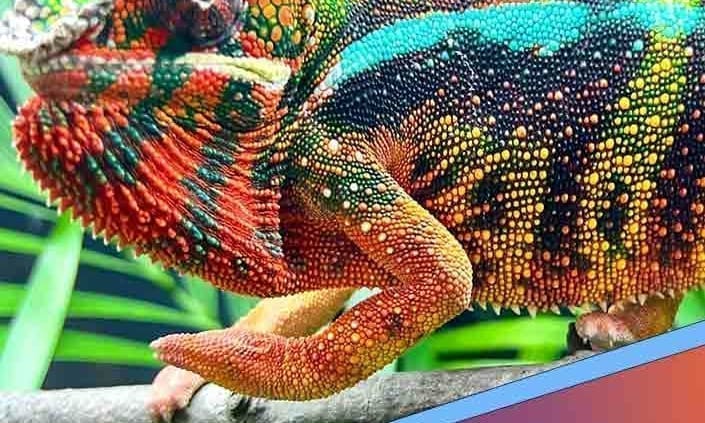
Ambanja Panther Chameleon: A Keeper’s Guide to Males vs. Females



What Makes the Ambanja Locale Unique?
“Locale” describes a naturally occurring regional population with distinct tendencies for color and pattern. Ambanja panthers are celebrated for rich blues and aquas that can look almost metallic under good lighting, often contrasted with soft greens and occasional purple hues. While individual expression varies, Ambanjas tend to hold cooler palettes even at rest, then “fire up” with deeper saturation during basking, courtship, or visual interactions. Good husbandry—especially correct UVB, stable hydration, and low stress—lets these tones develop fully as the animal matures.
Male vs. Female Ambanja: The Big Picture
1) Color & Pattern
Adult males are the head-turners. Expect bolder, brighter blues across the flanks, with distinct vertical barring that may intensify toward the head and dorsal ridge. Some males show turquoise washes or hints of violet, while others lean into powdery ice-blue bands. Females are subtler and gorgeous in their own right—think olive to soft green with light peach or tan accents. During receptive or gravid periods, females can shift toward corals, brown, or darker contrast patches, communicating their physiological state to nearby chameleons.
2) Size & Build
Males generally grow larger and more robust. An adult male Ambanja can reach roughly 15–20 inches in total length (including tail), with a thicker casque and broader head. Adult females typically range 10–14 inches and carry a lighter build, which can make them slightly easier to maneuver in dense foliage. Both sexes are agile climbers, but males often emphasize display postures using their longer bodies and tails.
3) Behavior & Temperament
Both sexes prefer calm routines and minimal handling. Males can be more overtly territorial, especially toward other males, and may display more frequently. Females tend to value thicker cover and privacy, but personality varies—some girls are inquisitive and front-perch regularly, especially when husbandry is dialed in. Reduce stress by providing leafy retreats, multiple perching routes, and gentle, predictable maintenance.
4) Longevity & Reproductive Needs
With excellent care, males commonly live 5–7+ years. Females may have slightly shorter lifespans due to the energetic cost of reproductive cycling. Even without mating, females can produce infertile clutches. Offering a discreet egg-laying site—a lidded bin or planter with 12–14 inches of moist, diggable substrate—helps prevent egg binding and reduces stress. Consistent hydration, balanced supplementation, and a quiet environment are especially important during cycles.
Habitat Setup for Ambanja Chameleons
Vertical space and ventilation are essential. For an adult male, a 24″ × 24″ × 48″ screen enclosure is ideal; an adult female can thrive in a slightly smaller setup, though more space is always welcome. Place the habitat on a stand so the highest perch sits above your eye level—chameleons feel safer when looking down across their world. Use a linear T5 HO UVB across most of the top; arrange branches 8–12 inches below the bulb to create a gentle UV gradient.
- Basking surface: ~85–90°F for males; ~80–85°F for females.
- Ambient daytime: mid-70s with a warm top and cooler base for gradient choices.
- Night drop: upper 60s supports natural rhythms and appetite.
Hydration follows a daily rhythm: morning and evening misting to bead leaves, plus a mid-day dripper. Many keepers add a cool-mist fogger at night (when temps are lower) to replicate humid, coastal forest conditions. Live plants—Pothos, Schefflera, Hibiscus—raise humidity, provide cover, and create natural highways. Rinse and repot into pesticide-free soil, and cover soil with large river stones or use plant stands to prevent accidental ingestion.
Diet & Supplements
Variety fuels health and color. Offer gut-loaded crickets, dubia roaches, black soldier fly larvae, silkworms, and occasional hornworms. Juveniles eat daily; adults usually every other day with moderate portions. Dust most feedings lightly with plain calcium (no D3). Use D3 and a multivitamin sparingly—about twice per month each—unless a reptile veterinarian advises otherwise. For gut-loading, feed your insects dark leafy greens, squash, sweet potato, and high-quality insect chows for 24–48 hours pre-feeding.
Choosing a Male or a Female Ambanja
If you’re dreaming of a high-impact display animal, a male’s larger size and ice-blue saturation often steal the show, especially under a well-tuned UVB and basking setup. If you prefer a slightly smaller chameleon with understated beauty and a calm presence, a female can be wonderfully rewarding—just be prepared with an egg-laying site and excellent hydration during cycles. Either way, prioritize health indicators: clear, alert eyes; steady perching; eager feeding responses; and smooth, coordinated movement among branches.
Why Start With a Reputable Breeder?
Early development sets the stage for everything that follows. Animals raised with correct UVB, hydration, and diet acclimate faster and color up more reliably. Lineage transparency helps you anticipate patterns and hues, which is especially fun with Ambanja’s cool palette. For over a decade, CB Reptile has earned a trusted reputation for robust Ambanja lines, thoughtful keeper education, and responsive post-purchase support—an ideal foundation for long-term success.
Getting Started & Next Steps
Before bringing your chameleon home, fully dial in the habitat: lights on timers, mister and dripper scheduled, plants rinsed and placed for dense cover, and drainage ready. When you’re set, explore availability of ambanja panther chameleons for sale from experienced, supportive professionals. If your heart is set on a graceful lady with classic Ambanja charm, you can also check for a female panther chameleon for sale.
Quick Male vs. Female Snapshot
- Coloration: Males = saturated blues/teals with strong barring; Females = softer greens with peach or tan accents.
- Size: Males larger and more robust; females smaller, lighter build.
- Behavior: Males may display territorial postures; females value thicker plant cover and privacy.
- Care: Both need tall, airy enclosures, strong UVB, precise basking, and reliable hydration cycles.
- Special note: Provide a discreet laying bin for females even if not bred; monitor hydration and nutrition closely during cycles.
